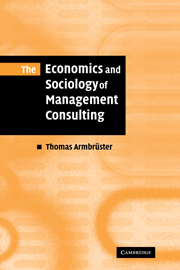Book contents
- Frontmatter
- Contents
- List of figures
- List of tables
- Preface and acknowledgments
- 1 Management consultancy viewed from economic and sociological perspectives
- Part I The mechanisms of the consulting market
- Part II The drivers of managing a consulting firm
- 6 Diversified services or niche focus? Strategies of consulting firms
- 7 Fostering reputation and growth? Marketing consulting services
- 8 The economics and sociology of knowledge distribution: organizational structure and governance
- 9 Gaining talent and signaling quality: human resource management
- Part III Conclusions
- References
- Index
9 - Gaining talent and signaling quality: human resource management
Published online by Cambridge University Press: 22 September 2009
- Frontmatter
- Contents
- List of figures
- List of tables
- Preface and acknowledgments
- 1 Management consultancy viewed from economic and sociological perspectives
- Part I The mechanisms of the consulting market
- Part II The drivers of managing a consulting firm
- 6 Diversified services or niche focus? Strategies of consulting firms
- 7 Fostering reputation and growth? Marketing consulting services
- 8 The economics and sociology of knowledge distribution: organizational structure and governance
- 9 Gaining talent and signaling quality: human resource management
- Part III Conclusions
- References
- Index
Summary
To consulting firms, human resource management (HRM) is vital for two reasons. First, they need personnel who are capable of performing cognitive abstractions and mathematical procedures of varying complexity. And, second, in a market of experience and credence goods, the quality of human resources signals consulting quality. The fact that the leading consulting firms comprise some of the most sought-after organizations for graduates from prestigious business schools and universities to work in is central to their business. Graduates and members of the business environment not only view these firms as springboards for senior managerial positions but also associate them with an elite status. Being hired by a leading consulting firm considerably enhances the self-esteem of graduates, who have often stuck at their studies for several years in order to gain placement in such a firm. This, in turn, nurtures the reputation of these firms in the management arena, and the procedures of personnel selection are a constitutive element in this cycle.
This chapter introduces and seeks to explain personnel selection and promotion policies in consulting firms. As far as the selection of personnel is concerned, I argue that the main outcomes are the signaling effect to the business environment and the social homogenization effect within the firm. As far as promotion procedures are concerned, I first review the economic literature on “up or out” tournaments and rat races, and then use the example of female consultants to introduce embeddedness-related and neoinstitutional mechanisms of promotion.
- Type
- Chapter
- Information
- The Economics and Sociology of Management Consulting , pp. 178 - 202Publisher: Cambridge University PressPrint publication year: 2006



